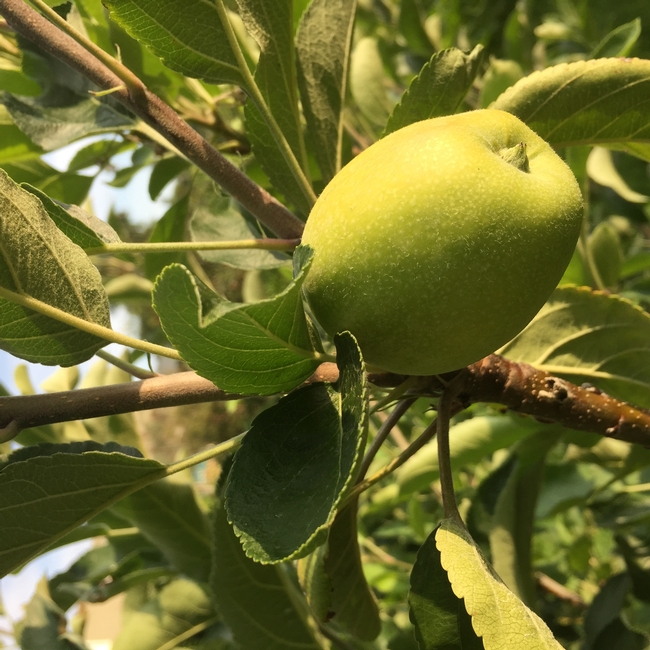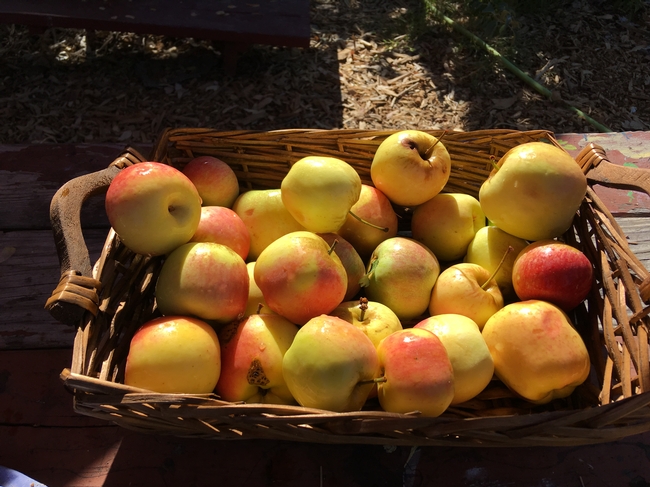- Author: Herb Machleder
The Apple is an iconic fruit, and here's where it all began.
It started in Genesis, the first chapter of the Bible, with the story of Adam and Eve and the fruit that explains good and evil. In 400 CE., when Pope Damasus had the Hebrew bible translated into Latin, the clever scholar used the Latin word malus for the tree, the fruit, and its properties. Malus was the Latin word for evil, but also the botanical name for the apple. And so in John Milton's epic poem Paradise Lost, the apple tree was securely established as the tree in the center of the Garden of Eden! William Blake's illustration is from the first edition of the poem.
Apples actually originated in the Tian Shan mountains of Kazakhstan, and there is evidence of grafted specimens dating from 2,000 BCE at sites around the Eastern Mediterranean. The apple continues to maintain its mystique and unique place among our fruit trees.
A couple of weeks ago I found a small bag in the market, and had my first “Cosmic Crisp” apple. In December, a small quantity of this brand new apple cultivar was released for the first time from a few licensed orchards in Washington State. What were the taste and texture like? You could call it “a Honey Crisp on Steroids.” The first bite is like a mini clap of thunder, and then comes the wonderful flavor. Washington State produces 40.8 million boxes of apples a year, but this year only 163,000 will be Cosmic Crisp for the entire country. Apple growers in Washington put up $40,000,000, and it took Washington State 22 years to develop the apple WA 38 from the time of the first cross in 1997 between a Honeycrisp and an Enterprise cultivar. The Honey Crisp is no longer in patent, and the MG Orchard Team has grafted its own Honey Crisp apple scions onto home grown seedling rootstock.
Why do you have to use a Graft? Planted from seed, an apple tree will grow but you won't have fruit for 4-6 years, and even then you're not likely to like anything about it. But, if you graft a little shoot (or even 1 bud) from a mature tree that has fruit that you prefer on the top of that seedling , you'll certainly have your first apples in the very next season, and just the kind that you like. The folks around the Mediterranean obviously figured that out 4,000 years ago where the first grafts were made….. good going, guys!
In fact, one of the very finest apples to grow right here (even in Santa Monica, with only 20 chill hours) is an ancient apple from the Jordan Valley. But more about that in a few minutes.
There are hundreds of varieties or cultivars. (Review time: A cultivar is a natural occurring variety that has been selected and cultivated, hence “cultivar”) with many different colors, flavors, textures, ripening times, chill hours, rootstocks, and growing configurations. They can fit anywhere: in the orchard, against a wall, along a fence, in a narrow median between a parking lot and a school, in a backyard, on a rooftop, or on a patio or balcony. Our MG Orchard Team has been grafting varieties and rootstocks and planting in all sorts of configurations.
How should we start? First choose the cultivars (varieties) that you would like to grow. Nursery catalogues will help you decide on color, taste (sweet (Fuji) , tart (Granny Smith) or one of the many complex flavors. Then look at the chill hours that the tree needs for its dormant period.
So what are chill hours? These are the number of hours between 32⁰ and 45⁰ F that the tree requires during the winter months to maintain dormancy, basically to get enough rest to blossom out vigorously come spring. There are 9 different chill areas in Los Angeles County, and you can check the average number of chill hours at the CIMIS station closest to your garden. If the chill hours on your prospective tree are too much lower than your area, the tree may blossom out on an unseasonably warm day in December (I'm sure you've seen that on those occasional days when the temp hits 80⁰). Then a week or two later in January, when the temp drops to the 30⁰s, there are no bees around to pollinate and your blossoms drop off. There goes your crop for that season. There may be a few blossoms left that didn't open, but it's not going to be a good year for that tree.
If your chill hours are not enough for what your tree needs (your CIMIS area number is lower than the tree label number), then when Spring comes and it warms up (no more chill hours), it won't have had enough rest to really blossom out. As it gets warmer and warmer the tree will eventually set blossoms, but there may not be enough time left to ripen the fruit. I'm sure that you've seen that, where there is plenty of unripe fruit left on the tree, and the season is over. For chill hour information, visit http://fruitsandnuts.ucdavis.edu/Weather_Services/Chill_Calculators/
All types of trees will grow well in our Mediterranean climate, but to have a decent crop of fruit, you'll need to get the chill hours right. Most of our coastal cities in Los Angeles County will do well with trees that require 200 to 300 chill hours. Sometimes these trees' labels will just say “low-chill” and not give you the exact numbers, and that's OK.
“Anna” (from the Jordan Valley), “Dorset Golden” (from Mrs, Dorset's garden in Bermuda), “Beverly Hills” (you guessed it….. from the time Beverly Hills was just farms and orchards. It was developed by WH Chandler, when UCLA was a great agricultural School, in 1929), Gordon, Fuji, and Gala will all give you great crops in “low chill” areas.
Apple Tree Care: Apple trees like to grow straight up, but they set fruit when their arms are straight out. So: Keep one 
Apples need some IPM so that you have a nice disease free growing season. You can wait for problems and then treat them with chemical sprays, or you can be proactive and preventive. White wash the trunk (50:50, water + water soluble white latex primer). Wrap a band of tanglefoot 1 foot up the trunk, and put a Terro Borax stake at the base of the trunk. Best protection your beneficials ever had! Spray only in the dormant season (when you do no harm). One spray of sulfur at Thanksgiving, one spray of copper at Christmas, and one spray of horticultural oil at SuperBowl Sunday. This is the way the organic orchards do it all up and down the Central Coast….. and, you're ready for Certified Organic (CCOF) if you care.
Compost your cuttings, leaves, extra fruit, and culls. Spread that around the drip lines, and you've returned all the micronutrients and humus to your trees. That's sustainability.
Use a balanced fertilizer for the first two years to get the tree up to speed (about 5-5-5 to 10-10-10) then drop off the Nitrogen (you don't want to grow firewood) you should already have all the branches you need. Use something like 3 to 5 for the 1st# (N), and 5-10 for “P” and “K”. You can purchase your fertilizer, or mix your own from organic components. Don't expect a good crop if your tree goes hungry.
Don't skimp on watering: The young tree will need about a gallon of water a day during the growing season. When mature, the tree can be watered twice a month, but it will need approximately the equivalent of 15 gallons of water per week. Reducing the water will force the tree to conserve. Its first defense is cutting down on fruit production, or even dropping the fruit. When September comes, drastically reduce the watering, and October to February may not need any supplemental water at all. Reducing the water encourages the tree to enter dormancy, and in our mild climate that is an important strategy. Above all: check the adequacy of your watering by inserting a rod (or straightened steel hanger wire) to a depth of 2 feet each time, until you're confident about your soil and technique.
When you can dent the apple skin and surface with the end of your thumb, pick and take a bite. If the seeds are dark brown or black, you're ready to pick a basket and share them with your friends. Nothing is better than a ripe, crunchy apple picked right off the tree!
And that is why “Every Garden Should Have an Apple Tree.” So have fun. And remember when you go into the orchard, you too are part of the ecosystem.
Photo credits: Jessica Yarger



